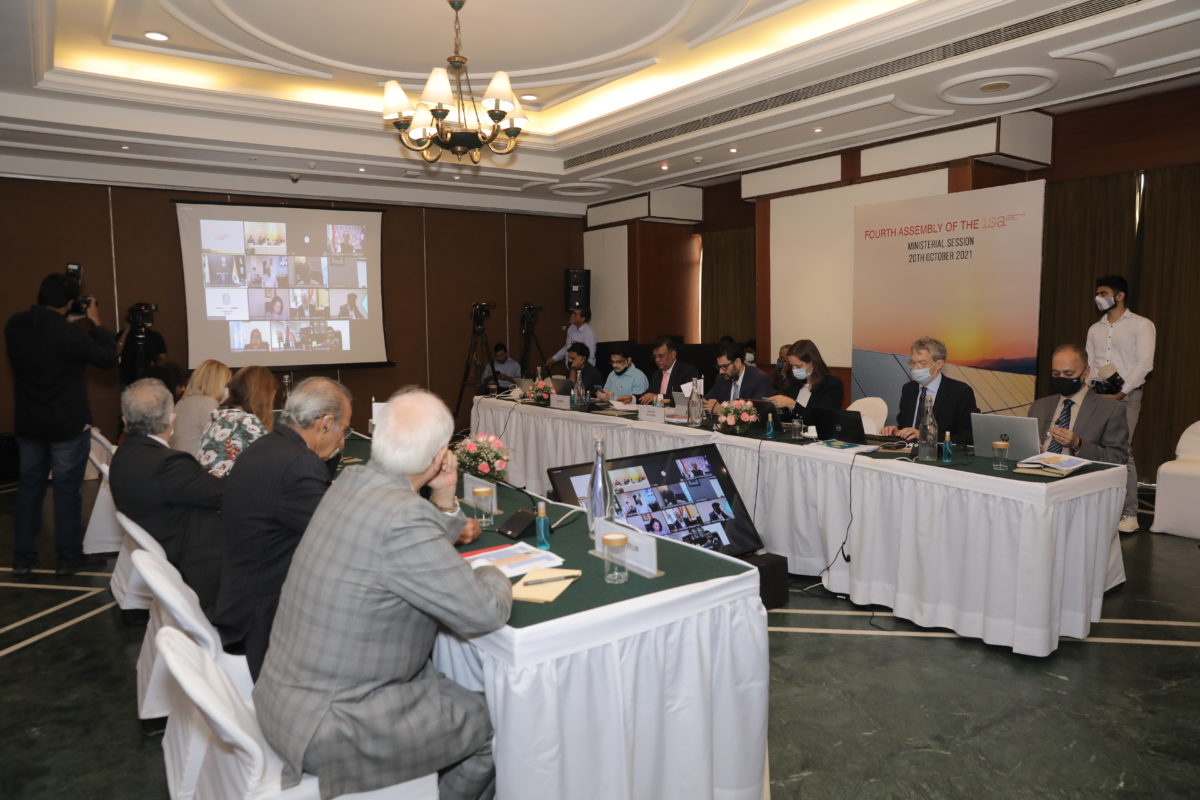The fourth general assembly of the International Solar Alliance (ISA) concluded yesterday with a promise to achieve $1 trillion global in solar investments by 2030. The four-day event was presided by R.K. Singh, power, new and renewable energy, the government of India, and the president of the ISA Assembly. A total of 108 countries participated in the Assembly, including 74 member countries and 34 observer and prospective countries, 23 partner organizations, and 33 special invitee organizations.
The ISA aims to reduce the cost of solar technology and finance to facilitate the deployment of more than 1 TW of solar generation capacity and mobilize more than $1 trillion of solar power investment by 2030 in its member countries.
The fourth assembly saw the ISA going a step further to take panel and battery waste management in its fold. Two new programs were launched: Management of Solar PV panels & battery usage waste & Solar Hydrogen program. The new Hydrogen initiative is aimed at enabling the use of solar electricity to produce hydrogen more affordably at US$2/kg than the current rate of US$ 5/kg.
The discussions at the Assembly highlighted that the MSME clusters can replace diesel gensets with hydrogen, which are viable even at today’s solar hydrogen prices. The ISA’s waste management program is intended to address the challenges of the growing volume of waste and toxic materials, lack of waste-specific legislation, and high cost of waste treatment.
In his address to the assembly, India’s power minister R.K. Singh, “It is time for all of us to get together to make energy access using solar and renewable energy available. We have successfully done this in India, and it can be replicated globally. Solving the problem of energy access is more important than the energy transition. The energy transition is meaningless for those without energy. The ISA can enable energy access for 800 million people worldwide.”
“It is time for developed countries to direct the energy transitions funds they had committed at previous climate conferences. ISA will cover credit guarantees and help in driving green energy investments in these countries.”
The US$1 trillion of investment in solar by 2030, targeted by the ISA, would be significant in bringing the world closer to energy transitions needed.
“These investments will also enable infrastructure such as transmission, batteries, micro and mini-grids to get the solar electricity delivered when and where it is needed. Through initiatives such as the One Sun One World One Grid (OSOWOG), which are structured to foster interconnected solar energy infrastructure at a global scale, grid interconnection will be key for transitioning to clean energy systems,” said Dr. Ajay Mathur, Director General, ISA.
To achieve the ISA goals, France announced it will be granting 1 million euros to the ISA’s capacity-building program.
“In collaboration with UNIDP, we aim to mobilize regional and national energy centers for research and innovation. France remains fully committed to the implementation of solar projects in allied countries and hence, the required funds have been granted. Keeping development of infrastructure in mind, France welcomes India’s launch of the green grid initiative. Thus, I call upon our partners to support our efforts,” said French Minister of Ecological Transition and Co-President at the ISA Assembly, Barbara Pompili.
The European Union (EU) will also grant 1 million euros to the ISA’s capacity-building program.
U.S. Special Presidential Envoy for Climate John Kerry commended the work that every country here is doing as part of the International Solar Alliance.
“Solar energy is the most powerful tool that the world has in its toolkit to combat the climate crisis. Building a solar-powered economy won’t just slash carbon emissions, it’ll open enormous economic opportunities. The ISA is unique in its focus on spreading solar to emerging economies including small island states,” he said.
‘One Sun, One World, One Grid’ initiative
An update on the One Sun One World One Grid (OSOWOG) initiative was also discussed at the Assembly. The concept of a single global grid for solar was first outlined at the First Assembly of the ISA in late 2018. It envisions building and scaling inter-regional energy grids to share solar energy across the globe, leveraging the differences of time zones, seasons, resources, and prices between countries and regions. OSOWOG will also help decarbonize energy production, which is today the largest source of global greenhouse gas emissions.
Aiming to synergize its efforts and actions with other similar initiatives globally, OSOWOG has joined hands with GGI to form a unified GGI-OSOWOG initiative, which aims to contribute to the collaborative, rapid development of resilient grids globally – building on continental, regional and national grid infrastructure programs.
George Freeman, Member of Parliament; Minister for Science, Technology & Innovation for The United Kingdom, said, “Under the Modi-Johnson leadership, UK and India will together bring the ‘Green Girds Initiative’ and ‘One Sun, One World, One Grid’ at COP26. This is aimed at mobilizing the global technical, financial and research cooperation because it is only by working together that we will deliver the scale and pace of the clean power transition aim.”
This content is protected by copyright and may not be reused. If you want to cooperate with us and would like to reuse some of our content, please contact: editors@pv-magazine.com.









Helpful and informative article team!Hearing about OSOWOG concept from top 2 leaders of the world is very cheerful to people like of us.Keep doing such intiative and amazing things to the earth!